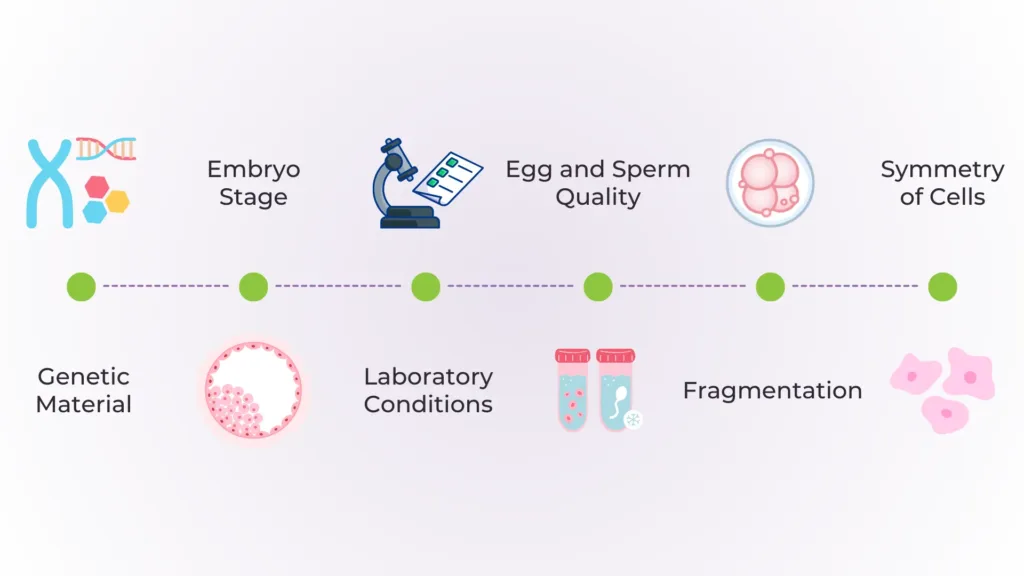Embryo grading helps fertility specialists evaluate the quality of embryos before transfer. Assessing the specific characteristics of embryos provides insights into their potential to implant. For intended parents, understanding how embryo grading works can make the often-complex IVF journey feel more transparent. This process helps select the best embryos to transfer and contributes to higher success rates and better outcomes. Embryo grading serves as a guide in choosing the embryos most likely to result in the ultimate goal of pregnancy and a healthy baby.
Factors That Affect Embryo Quality

Several factors influence the quality of an embryo, all of which play a role in determining its potential for implantation and development into a healthy pregnancy. These factors are assessed during the embryo grading to ensure the best possible outcomes in IVF.
- Genetic Material: The health and genetic integrity of the egg and sperm used to create the embryo are foundational to its quality. Chromosomal abnormalities in the egg or sperm can affect the embryo’s ability to grow and implant successfully.
- Embryo Development Stage: The stage at which an embryo is graded can also influence its quality. For example, day 3 embryos are evaluated based on the number of cells and their symmetry, while embryos at the blastocyst stage are graded on more advanced criteria, such as the structure of the fluid-filled cavity and the compactness of the inner cell mass.
- Laboratory Conditions: The IVF lab’s environment in which the embryo is cultured impacts its development. Controlled conditions, such as optimal temperature, pH levels, and nutrient availability, ensure the embryo’s growth is not hindered.
- Egg and Sperm Quality: The age of the egg provider and the overall health of both the egg and sperm contribute to embryo quality. Younger eggs and healthy sperm generally produce embryos that are more likely to reach the blastocyst stage and achieve implantation.
- Fragmentation: This refers to the presence of cellular debris within the embryo. Lower levels of fragmentation are associated with higher-quality embryos, as excessive debris can interfere with cell communication and growth.
- Symmetry of Cells: Embryos with evenly sized cells and uniform growth are considered higher quality. Uneven cell sizes or irregularities can indicate compromised development.
Types of Embryo Grading Systems
Embryo grading systems are used to evaluate embryos at different stages of their development, helping fertility specialists identify those with the best chance of implantation and resulting in a successful pregnancy. These systems focus on various physical and developmental characteristics, which change as the embryo matures.
Day 3 Grading
Day 3 grading evaluates embryos at the cleavage stage, approximately 72 hours after fertilization. At this point, embryos are typically composed of 6–10 cells, and the grading system focuses on their cellular structure and overall development. Ideally, a healthy day 3 embryo should have 8 evenly sized cells, as this symmetry indicates regular cell division and proper growth.
The grading process also assesses the presence of fragmentation, which refers to small, irregular fragments of cellular material within the embryo. While some fragmentation is normal, high levels can indicate developmental issues that may lower the embryo’s implantation potential. Minimal fragmentation is associated with better embryo quality and higher success rates.
Another factor in day 3 grading is the symmetry of the cells. Embryos with uniform, evenly sized cells are considered higher quality, suggesting that the cells are dividing at a consistent rate. In contrast, uneven or asymmetrical cells may indicate irregular development, though such embryos can sometimes still result in a successful pregnancy.
Day 3 grading provides an early snapshot of an embryo’s development and helps fertility specialists decide which embryos to monitor further or consider for transfer or freezing.
Blastocyst Grading Techniques
By day 5 or 6, embryos reach the blastocyst stage, a critical point in their development. At this stage, grading becomes more detailed, focusing on features that provide fertility specialists with a clearer picture of the embryo’s implantation potential.
For example, the inner cell mass (ICM) is the cluster of cells that will eventually form the fetus. Grading the ICM involves evaluating its appearance, with tightly packed and well-organized cells considered optimal (Grade A). Loosely arranged cells (Grade B) or sparse, disorganized cells (Grade C) may indicate lower quality, although such embryos can still sometimes result in successful pregnancies.
The trophectoderm, the outer layer of cells that forms the placenta, is another essential factor in blastocyst grading. The number and organization of these cells are assessed to determine their quality. Trophectoderm cells that are evenly distributed and abundant (Grade A) are ideal, while moderate irregularities (Grade B) or sparse cells (Grade C) suggest varying levels of implantation potential.
Lastly, the grading process examines the development of the blastocyst cavity, the fluid-filled space within the embryo. Terms like early blastocyst, expanded blastocyst, and full blastocyst describe its progression. A fully expanded cavity indicates the embryo’s readiness for implantation, making it a strong candidate for transfer.
Blastocyst grading offers a more thorough and predictive assessment of embryo quality compared to earlier stages. This detailed evaluation helps fertility specialists identify the embryos most likely to result in a successful pregnancy and a healthy baby, ultimately increasing the success rates of IVF.
Preimplantation Genetic Testing and Embryo Grading
Preimplantation genetic testing (PGT) testing complements embryo grading by analyzing embryos’ genetic health, providing a more complete assessment. While grading evaluates physical characteristics like symmetry and cell structure, PGT identifies chromosomal abnormalities that could affect implantation or pregnancy success. Typically performed at the blastocyst stage, PGT examines cells from the trophectoderm to detect issues like aneuploidy, helping prioritize the healthiest embryos for transfer. This combination is especially beneficial for patients with a history of miscarriages or limited viable embryos, increasing success rates and improving the chances of a healthy pregnancy.
Embryo Grading for IVF Success Rates
The relationship between embryo grading and IVF success rates lies in its ability to guide fertility specialists in selecting embryos with the highest implantation potential. High-quality embryos, as identified through grading, are more likely to develop into healthy pregnancies. However, it’s important to note that grading is only one part of the equation, and other factors like uterine health, timing, and the overall IVF protocol also play their role in determining success.
Embryo grading allows clinics to optimize the number of embryos to transfer, reducing the risks associated with multiple pregnancies while maintaining high chances of success. Also, it helps prioritize embryos for freezing, ensuring the best-quality embryos are preserved for future cycles. For patients undergoing elective single embryo transfer (eSET), grading becomes especially significant, as it determines which single embryo offers the highest likelihood of implantation.
While higher-graded embryos generally correlate with better success rates, lower-graded embryos can still result in pregnancies, underscoring the complexity of embryo development.
Interpreting the Embryo Grading Chart
An embryo grading chart simplifies the evaluation process by breaking down key characteristics of embryos, making it easier to assess their quality and potential. This chart can help intended parents decide which embryos to transfer or freeze. The structure of these charts varies depending on the embryo’s development stage.
Day 3 Embryo Grading Chart
For day 3 embryos, the chart typically includes:
- Number of cells: On a healthy day, 3 embryos should have 6–10 cells, with 8 cells being ideal.
- Symmetry: Uniform, evenly sized cells are graded higher, indicating normal development.
- Fragmentation: Minimal fragmentation is preferable. Excessive fragments reduce the embryo’s overall quality.
Example: An embryo might be graded as “8A,” meaning it has 8 cells with excellent structure and minimal fragmentation.
Blastocyst Grading Chart
For embryos at the blastocyst stage, the chart evaluates three main components:
- Inner Cell Mass (ICM): Graded on compactness and organization, as this becomes the fetus:
- A: Tightly packed and well-organised.
- B: Loosely packed.
- C: Sparse or disorganized.
- Trophectoderm: Assessed for the number and uniformity of cells that form the placenta:
- A: Numerous, evenly distributed cells.
- B: Moderate number, slight irregularities.
- C: Few, irregularly spaced cells.
- Blastocyst Cavity Expansion: Indicates the maturity of the embryo:
- Early blastocyst: Cavity is just beginning to form.
- Expanded blastocyst: Cavity fills the embryo and is larger than the original structure.
- Full blastocyst: The embryo is fully expanded and ready for implantation.
Example: A “4AA” blastocyst means the cavity is fully expanded (4), with excellent ICM (A) and trophectoderm (A).
Can Lower-Graded Embryos Lead to Pregnancy?
Yes, lower-graded embryos can still lead to successful pregnancies, as grading is not an absolute predictor of an embryo’s potential. While higher-graded embryos are typically prioritized due to their better structure and development, factors like uterine health, the timing of the transfer, and the overall IVF protocol also play important roles. Many lower-graded embryos have resulted in healthy pregnancies and babies, highlighting that grading is just one piece of the IVF puzzle. This emphasizes the importance of considering the whole picture rather than relying solely on grading criteria.
Questions to Ask About Embryo Grading

Asking the right questions can help clarify how grading impacts your chances of a successful pregnancy and what to expect from the process. Here are some questions to discuss with your fertility specialist:
- What do the grades assigned to my embryos mean for their implantation potential?
- How does the grading system used by the clinic evaluate embryo quality?
- Are there significant differences between the embryos graded as higher and lower quality in my case?
- Can lower-graded embryos still be transferred, and what are their chances of resulting in a pregnancy?
- How will the grading chart help determine which embryos to freeze for future cycles?
- Are there specific risks or benefits associated with transferring embryos of different grades?
- How many embryos do you recommend transferring based on their grades and my individual case?
- What should I expect in terms of success rates for embryos graded similarly to mine?
Embryo grading is an important tool in the IVF process, offering insights into the quality and potential of embryos to result in a successful pregnancy. While higher-graded embryos are often prioritized, it’s important to remember that grading is only one factor among many that contribute to IVF success. Combining embryo grading with advanced techniques like preimplantation genetic testing and consulting with fertility specialists ensures a well-rounded approach to selecting the best embryos for transfer.























